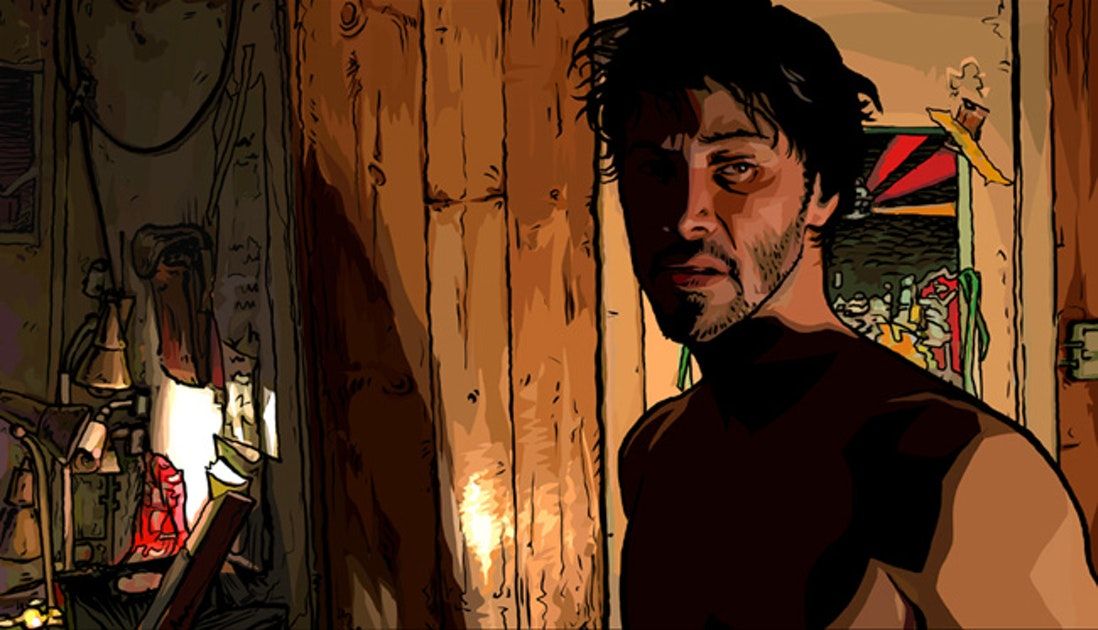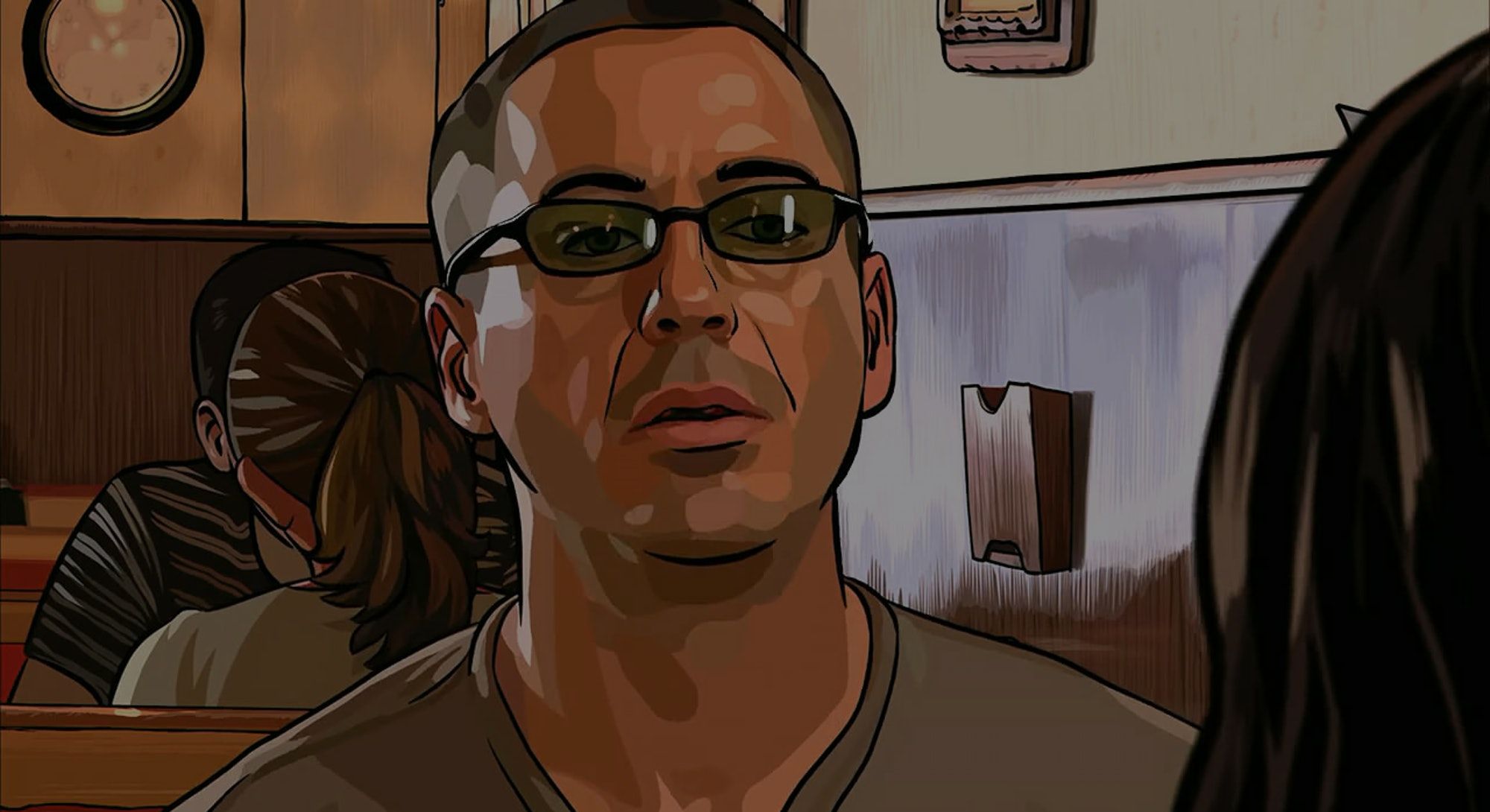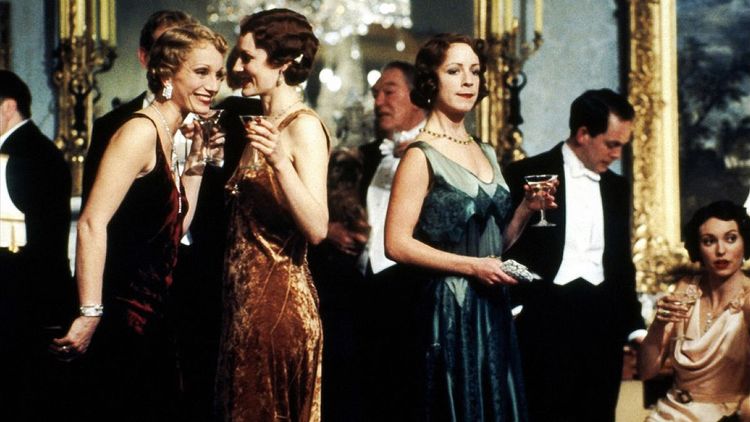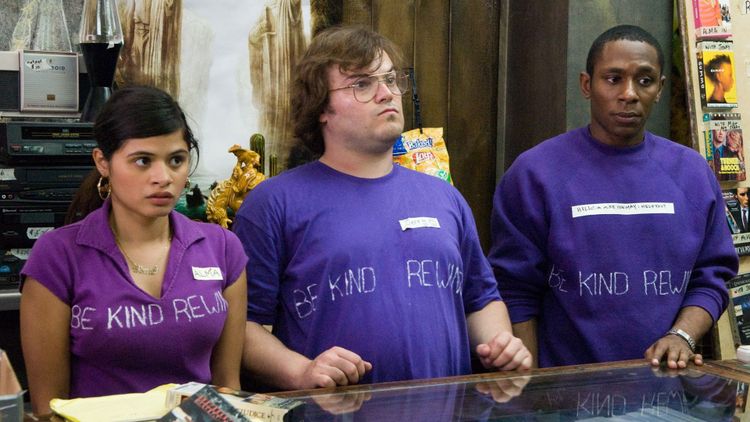Adventures in DVD #1: “A Scanner Darkly”
A Scanner Darkly is a perfect vision of Philip K. Dick filtered through director Richard Linklater’s dirtbag lens. It’s a pure piece of Dickian science fiction cinema, yet one mostly set in the presence of listless men in their thirties, drifting through the days, smart but under motivated, dodging every hard question life puts to them. Some of the best scenes feature the male characters—which, apart from Winona Ryder’s role, is almost all of them—either drugged up and messing around like teenagers, or drugged up and having meandering conversations that lead nowhere. These are men who have assembled their life into a permanent lost weekend.
In one key scene, Keanu Reeves’ Bob Arctor, an undercover narc spiralling into drug addiction, has a flashback (or maybe a hallucination) of a life with a wife and 2.4 children that he may have abandoned. Or maybe they abandoned him, if they ever actually existed. Arctor chews on his disgust at what many would describe as a normal life. “My house, my family, my backyard, my power mower. Nothing would ever change; nothing new could ever be expected,” He almost sounds elated that his old life has been left in the past: “It had to end, and it did. Now in the dark world where I dwell, ugly things, and surprising things, and sometimes little wondrous things, spill out in me constantly, and I can count on nothing.”
A Scanner Darkly is about men so intent on dodging the trappings of adulthood they’ll firebomb their life and slide into “the dark world” just to feel something different. Sometimes it’s not the drugs that robs you of ambition, it’s the malaise of existence. Then the drugs follow. The story is set under Californian palm trees but the washed out vision it offers could be anywhere, America.
This was comfortable territory for Linklater, who went from making movies about aimless boys in the 1990s, like Slacker and Dazed and Confused, to making movies about men who refused to grow up in the 2000s, like Jack Black’s man-child musician Dewey Finn in School of Rock. His films are a caucus of languishing Generation Xers. It’s absolutely perfect that A Scanner Darkly saw Linklater turn to Hollywood stars from the ‘90s who’d had been through some lows in their lives and careers and were trying to tune their place in the new century. There’s Ryder, who after being an icon of Gen X was beset by personal problems and tabloid ghouls. There was Robert Downey Jr., right in a sweet period between kicking drugs and getting cast in Iron Man that saw him piece his career back together one brilliant supporting turn at a time. And there was Reeves, searching for interesting roles after the mammoth project that was The Matrix series. Keanu can sometimes come across as self-deprecating about his own acting ability. He’s also so good at the physical stuff in action movies that it can lead to a narrative that the man isn’t a good actor. You’re crazy if you believe it. It would have been so easy to play the drug-addicted Arctor in full Basketball Diaries parody. Instead, Reeves brings the perfect mix of lethargy and vulnerability; cool-guy chill and unbecoming desperation. It’s one of his best quiet performances.
Based on Dick’s 1977 novel, A Scanner Darkly retains the writer’s interest in how the hard lines of reality can sometimes blur—see also: Blade Runner and Total Recall—as well as his fear of authoritarianism. In one piece of casting that has not aged well, Alex Jones (yes, that Alex Jones) plays a guy with a megaphone trying to warn uninterested shoppers of government tyranny only to be hauled into the back of a van by masked agents of the state.
Setting the book apart from the rest of Dick’s oeuvre is the very direct influence of his experience with drug addiction. How his use of amphetamines inspired many of the story’s key beats has been pored over many times, so I won’t go into too much detail here. Notably, Dick became a participant in the X-Kalay rehab center, which sparked the notion of such institutes being used to secretly harvest drugs. There was no authority figure that Dick could not envision as being corrupt.
I guess you could call A Scanner Darkly an anti-drug public service announcement. The pills are corrosive, never gratifying. The hallucinations are disturbing, never euphoric.

The story sets off with Arctor creeping his way up the drug supply chain, closing in on a major bust. On his way he gets hooked on Substance D, a hallucinogenic drug that has ensnared 20 percent of the US population. In response, the government has developed an invasive surveillance policy in which Arctor serves as a cog. At work, he goes by “Fred,” maintaining anonymity by wearing a “scramble suit” that constantly alters his appearance and voice. Arctor spends much of his work day surveying his own home, including housemates Barris (Downey Jr.) and Luckman (Woody Harrelson playing a California beach bum but with, y’know, a Woody Harrelson accent). He spends his downtime dropping D with his circle of friends, which includes his dealer and would-be girlfriend Donna (Ryder). The group occasionally interact with Rory Cochrane’s tweaked-out basehead, who channels major Benicio Del Toro energy.
The extent of Arctor’s anonymity isn’t always clear. His superior “Hank” appears to recognize the possibility that “Fred” is a member of Arctor’s circle or maybe even Arctor himself. If you started out with that information, it wouldn’t take Columbo to figure out who “Fred” really is given his relative height to the other persons of interest. But by that point it hardly matters. Even Arctor starts to forget where one persona ends and the other begins. The edges of his reality blur as he stares at the screens of the surveillance system day after day, barely recognising his own image.
Of course, we discover that Arctor never really has privacy. “Hank” is actually Donna, who plots Arctor’s psychological downfall so he, as a genuine addict, can invade the New-Path rehab facility secretly responsible for the manufacture and distribution of Substance D. His grip on reality broken by the drug, Arctor is checked into New-Path under the name “Bruce.” Despite “Bruce” being little more than a shell of man with no hard memories of his previous life, “Donna”—whose real, real name is Audrey—hopes that the subtle psychological programming he has undergone with lead him to instinctively obtain evidence on the facility.
The movie demands rewatches to spot the programming techniques used on Arctor. For example, a medic suggests he brings Donna some blue flowers, which he is compelled to do when, in the final scene, he comes across hidden rows of the flower that produces Substance D at New-Path. But you don’t need close examination to see that this is the ultimate form of government surveillance—using one of its own citizens as a spy tool. Dick conceived the story during Nixon era spy games but the parallels between ever-increasing modern day invasions have only intensified since the movie’s release are easy to spot.
Throughout the film, Arctor undergoes a series of (supposed) psychological examinations to test his mental competency. These scenes perch him across a cold table from two government medics. It’s strongly reminiscent of that bit in The Matrix when Agents interrogate office rat Thomas Anderson. The idea of doing another science fiction that examines the nature of reality must have made Reeves pause, but it’s tough to imagine two sci-fi movies presented more differently. Set in “the near future,” Linklater makes no attempts to decorate the reality we are crashing towards with gadgets or lasers—a totally different approach than the brilliantly expansive Spielberg take on Philip K. Dick Minority Report, released four years earlier. By not presenting a highly stylized vision of dystopia, the message is that this disastrous future is entirely of our own creation.
On the move through it all is Downey Jr’s idiosyncratic tech geek James Barris, who gets a load of the funniest lines (“This is a world getting progressively worse. Can we not agree on that?”). This was the actor’s best period, when he made all kinds of movies (and weird pop-jazz music) before the Marvel universe became such a time drag. I just adore that prolific 2005-2008 run—Kiss Kiss Bang Bang, Good Night, and Good Luck, Zodiac, Charlie Bartlett and a bunch of others—where he showed what a great film actor he really is. A Scanner Darkly is one of those movies where every RDJ line sounds snappy.
I’ve made it this far without mentioning that the most immediately identifiable thing about A Scanner Darkly is, of course, that it appears to be a cartoon. As he’d previously done on Waking Life, Linklater filmed his actors more or less as he would any of movie and then used Rotoscoping to transform the footage into animation. These days Instagram might trick you into believing that the director simply put a filter on his movie and that was that. But Rotoscoping is a painstaking process, even in 2006. Postproduction took 18 months—twice as long as Linklater had anticipated.
If you were to step to this movie cold, I doubt you’d be tricked into believing it was animated from scratch. A Scanner Darkly never feels like it was drawn by a team of artists, like Beauty and The Beast or whatever, or even that it was computer animated like a Pixar movie. What matters is that the illusion of thick black pen outlines and vibrant paint reflects the characters’ bleary senses. It feels like at any moment you could reach out and smudge the paint with your own fingers, scrambling Arctor’s face into an indistinct mess as he loses his edge. Watching the movie sometimes makes me feel like I’m playing an old point-and-click video game and with a movement of a mouse I could investigate every corner or Arctor’s house. As a fan I’d love to see the original footage but, as far as I’m aware, none of it is out there for public consumption.

I guarantee you there was a couple of executives in the background who thought Rotoscoping this movie was commercial suicide—its major star power diluted by the fact that casual moviegoers looking at posters outside a cinema would have no interest in seeing some weird cartoon. A Scanner Darkly was distributed by Warner Independent Pictures, a funny and kind of sickening concept whereby mega-company Warner Bros ostensibly tried to replicate the aesthetic of indie cinema. (The first movie Warner Independent Pictures released was actually Linklater’s beloved Before Sunset.) It’s easy to be cynical about this kind of thing—and you should be—but even I can’t deny that Linklater is a genuine American maverick who has a knack of operating in Hollywood with minimum compromise. By the time A Scanner Darkly was released, he was five years working on his epic Boyhood.
Punctuating the futureshock of A Scanner Darkly’s stripped-down dystopia is the presence of Thom Yorke’s “Black Swan.” The song appears on the closing credits but a snippet can be heard playing on a radio in the film’s universe. Lifted from the Radiohead vaudevillian’s solo record The Eraser—which I probably played more than anybody back in the day—Yorke does a good impression of what a pop song might have sounded like in “the near future.” I listened to the album again recently and its skeletal arrangements have aged gracefully in 15 years. Though frequently led by Yorke’s environmentalism with occasional forays into the news cycle—“Harrowdown Hill” is about whistleblower David Kelly, who died after telling a reporter that the British government had falsely identified weapons of mass destruction in Iraq—it felt almost like an unofficial soundtrack to A Scanner Darkly: brooding, minimalist, eternal. The second verse of “Black Swan” even reflects the movie’s message.
People get crushed like biscuit crumbs
And laid down in the bitumen
You have tried your best to please everyone
But it just isn't happening
No, it just isn't happening
That’s the crush of authoritarianism. That’s the malignancy of what real life can do. Dick never trusted authority; Linklater knows that some many don’t want to be an authority to even themselves. They are made to let the darkness in.
Adventures in DVD is my series on every great movie of the 2000s. This first is installment on me but to receive all future posts please subscribe.


